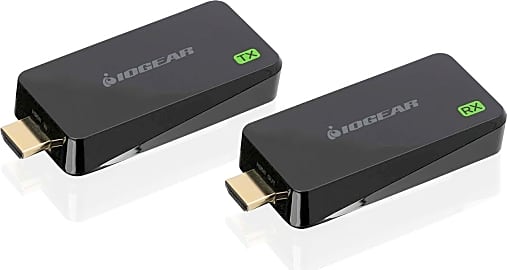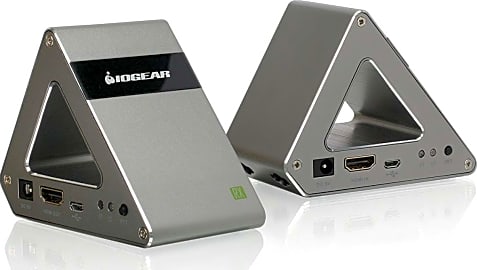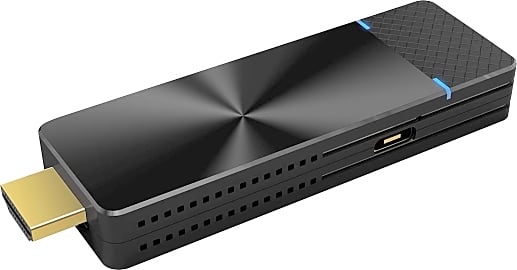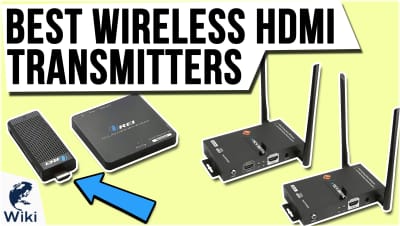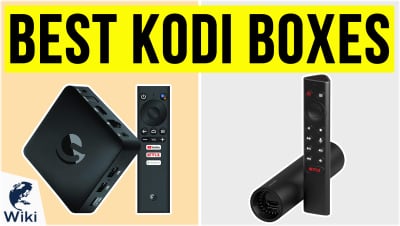The 8 Best Wireless Display Adapters

This wiki has been updated 31 times since it was first published in December of 2017. It's no longer difficult to send the video from a smartphone, computer monitor, or Blu-ray player to a television screen across the room without running any unsightly cables. Here are some wireless HDMI adapters, set-top streaming boxes, and high-end transmitter and receiver pairs that can mirror your screen and get your favorite show on the TV, even if you don't have Internet access. When users buy our independently chosen editorial picks, we may earn commissions to help fund the Wiki.
Editor's Notes
December 04, 2020:
Wireless video transmission isn't always as easy as plugging in a dongle and pressing a couple buttons, but it doesn't necessarily have to be too difficult. The well-known Google Chromecast is as simple as it gets, and makes it especially easy to cast your screen to a non-wireless display. The most recent Microsoft Wireless Display Adapter shouldn't be much tougher to use, and it allows for a 4K image. The ScreenBeam Mini2 is similarly straightforward and affordable.
Not every setup works perfectly with those choices, though. If your device doesn't support Miracast or you want better video quality, the Nvidia Shield TV is worth a look. Actually, it's one of the most impressive home entertainment devices on the market right now, and it's great for a bunch of other things, including gaming - although for that, you'll want to make sure you get the high-powered Pro version. The Apple TV 4K is a lot like the Shield, but minus much of the games, and with full support for Apple devices. In fact, if streaming your iPhone or iPad without major hassles is important to you, there aren't really any others that do it so well, and third-party support for Apple's proprietary standards is all but nonexistent. There are some apps you can buy that work okay, but not nearly as well as Apple's own device.
There are a few others worth mentioning, although they're not meant for the average home user. The IOGear GH60 uses the 60-gigahertz band to deliver uncompressed video and up to 7.1-channel surround sound, but without a line of sight it won't work. The IOGear SharePro is meant for ad hoc point-to-point transmission, and the EZCast Pro II for multi-point video sharing. Be aware, however, that the EZCast is considerably tougher to set up than most others.
If you only rarely need screen mirroring or casting, many simple streaming devices offer good-to-passable support, though you'll want to verify it first. Alternatively, tech-savvy users might prefer to set up a wireless HDMI extender in some situations, but that's definitely not for the casual movie watcher.
June 28, 2019:
There are many different purposes, protocols, and pitfalls involved with wireless video transmission, so make sure to choose carefully. First of all, the second version of the Microsoft Adapter failed to make the list this time because its compatibility and ease of use seem to be dropping, according to many users. Also, the Apple TV fell off because there are other choices with more versatile functionality that cost less and work great with iOS and macOS.
The Nyrius, IOGear, J-Tech Digital, and DVDO are all high-powered transmitter/receiver setups that move data in one way or another. The Nyrius and J-Tech use the 5ghz band to transmit a 1080p signal with 5.1-channel surround, which basically maxes out the bandwidth, and can choke up an already crowded wireless environment. The IOGear GH60 and DVDO use the high-frequency 60ghz band, so their range is much shorter and they need a line of sight, but they don't have to use lossy compression and they don't suffer from lag. IOGear's SharePro is similar to the former group, but as you can see, it's quite a bit more compact, consisting of two simple dongles. As such, it's a great choice for traveling businessmen or IT professionals who need access to big screens without the hassle of wires.
Then there's the streaming and screen mirroring side of things. As far as ease of use goes, the Roku, ScreenBeam Mini, and Chromecast are hard to beat, though they are of course quite different. Roku offers a wealth of integrated streaming options and a little less screen casting versatility, while Chromecast is exclusively a mirroring protocol that has a wide range of compatibility and is quite simple to set up and operate. ScreenBeam is very similar to Chromecast although it uses the Miracast standard, and it's even less restrictive than Google's popular product, though it isn't quite as reliable.
Then there are two that really stand apart. The EZCast Pro II is an upstart little dongle that can add a ton of functionality to any boardroom with a big TV, as it provides some features that you'd normally see on highly expensive wireless presentation systems. And there's the Nvidia Shield, which takes all of the well-engineered components and technologies that Nvidia could round up, and wraps them up in Google's official Android TV OS. It's fast, it's widely compatible, and it can even turn the average couch potato into an avid gamer thanks to its library of streamed titles. Incidentally, that's also why I'd personally recommend getting the package with the controller and the GeForce NOW subscription.
We also highlighted some software-based media platforms that can turn your laptop or desktop into a bona fide media server, complete with worldwide remote access. And businesspeople on a mission should check out Mersive's Solstice line. Those versatile and somewhat involved options are listed in the Special Honors section.
Special Honors
Emby Server It has a lot in common with other home server programs, but Emby is a little bit more polished and also offers its own large media library as well as tight integration with Kodi, an extremely popular streaming platform. It's not the absolute easiest to use, but it is pretty close, and gives you a ton of in-depth control options so you can tailor your experience to your needs. emby.media
Mersive Solstice If you need to get some work done efficiently, and with coworkers spaced out all around the world, this powerful box can help you do so. It comes in a few varieties each of which provide increasing levels of teleconferencing, bring-your-own device, and digital collaboration abilities. If you're looking to outfit a busy office, spend some time figuring out which package suits your needs, because high-end AV professionals often agree that this particular line is one of the best wireless presentation systems around. mersive.com
Chromecast with Google TV The latest generation of Google's popular dongle is the most advanced yet, and marks the tech giant's inevitable entry into the streaming stick market. Unlike previous iterations, it has a range of various apps built in, allowing for 4K HDR content streaming from HDCP-protected sources such as Netflix. store.google.com
Why Do We Want Wireless?
The rest of us might want to consider a wireless display adapter to take all of that extra handiwork out of the equation.
The home entertainment industry has exploded in recent years. The latest image processors and panel configurations deliver brightness, realism, and immersion that were unimaginable at the advent of television, and the sheer volume of content available is unmatched throughout history — and it only continues to grow. Just a few decades ago, taking advantage of the latest hardware and content often required painstaking efforts, sentencing would-be DIY home theater installers to hours of lugging heavy equipment; measuring, stripping, and hiding cables; running power to amplifiers; and making sure all analog media was in solid, dust-free condition.
Not so anymore.
Engineers have gone out of their way to make it simple to enjoy digital entertainment. Gone are the massive, wood-paneled 1970s sound systems, and the monstrous, first big-screen TVs. In their places are slim soundbars and low-profile subwoofers, along with widescreen LED TVs that can be surprisingly lightweight. Where coaxial cables once ruled the roost and shared signal-distorting interference behind huge cabinets, right-angle connectors, optical audio, and digital transmission are now the order of the day among hi-fidelity setups. The need for an actual, physical cable has dwindled with the rapid development of powerful wireless transmission methods. After all, whether you own a home or rent an apartment, who really wants to pull up baseboards, cut wires, and hide Cat-7 cable throughout every room? Some people need the assurance of a wired connection, and are quick and talented at minor construction and electronics projects. The rest of us might want to consider a wireless display adapter to take all of that extra handiwork out of the equation.
Blockbuster: A Requiem
Another home-entertainment staple nearly gone the way of the dinosaurs is physical media itself. Formerly recorded on formats like VHS and DVD, movies and TV shows are almost all now available digitally, downloaded or streamed directly from the web. The days of the family trip to the movie store are history; now everything from Ben Hur to Baby Driver is available with just a few keystrokes and the right subscription service. Entire seasons of the most popular broadcast programming are offered on a variety of websites, and many of the distribution outlets now produce their own, high-quality, original content. This unprecedented availability has completely changed the way the entire movie and TV industries operate.
So, you've shelled out big bucks for the fastest fiber internet, and perched your 85-inch flat panel atop a reliable stand. Meanwhile, your satellite speakers and center channel are all properly configured. In order to avoid general overexertion and unnecessary labor, you'll need a way to get that stream from the ISP, through the router, and to the television, without using any tools or making permanent changes to the space. There are several different methods of connecting the whole outfit, each with its own advantages and drawbacks.
An Abundance Of Transmissions
There are a few general classes of wireless adapters, and the right choice depends on what kind of media you're transferring, and where it's coming from. The simplest method is a very straightforward receiver that plugs directly into the television. This is a great choice if you're already supplying a source of media, like a collection of downloaded movies, a business presentation, or multiple streaming services via PC.
Such devices are great all-in-one solutions, and they're usually a breeze to set up and operate.
On the other hand, if you'd like to cover the entire process with one new piece of equipment, streaming devices like those from Roku have been around since the beginning, and still host a huge range of programming. Keep in mind, though, if you intend to watch new releases in all their 4K HDR glory, you'll need not only a relatively fast internet connection, but also an adapter that supports the most recent HDCP, the anti-piracy verification protocol. If you're transmitting from a computer to a simple wireless receiver on your television, your 4K access may be restricted, and there may not be a way around it. And for what it's worth, with a little expertise and possibly an inexpensive app, it's not too difficult to configure a major-brand streaming stick to receive a wireless broadcast from your PC or smartphone. With that being said, not all TV sticks are created equal; some are faster and easier to use, and different services offer varying shows and movies, especially now that original content seems to come from every direction.
Certain gaming consoles feature built-in access to quite a few video games in addition to film and television services. The Xbox was actually the initial development and release platform for what would become Kodi, one of the most popular open-source streaming protocols ever. Such devices are great all-in-one solutions, and they're usually a breeze to set up and operate.
Speaking of gaming, there's another upstart technology that may revolutionize parts of the internet experience. It's not very widespread yet, but the 802.11ad standard, also known Wi-Gig, takes short-range transmission to a new level. It raises the frequency level of the transmissions from the 2.4-GHz and 5-GHz Wi-Fi bands to the similarly unlicensed 60-GHz band. This high-energy signal carries a theoretical maximum of 875 megabytes per second, about five times the top speed of 802.11ac Wi-Fi. The 60-GHz transmission is nearly impervious to electromagnetic interference, and reaches the screen with almost zero latency — ideal for fast-paced, action-packed gaming. However, it's limited to a range of only 30 feet, and it requires line-of-sight contact with the receiver. Since it can't pass through walls, and few people need such ludicrous speeds, Wi-Gig is a bit of a niche product, albeit an advanced one.
While there are many different wireless display adapters to choose from, a lot of them work quite well. Whether you're a frequent business traveler, avid online gamer, or devoted binge-watcher, you'll no longer be tethered to the TV, and you won't have to sacrifice the quality of your multimedia experience.






